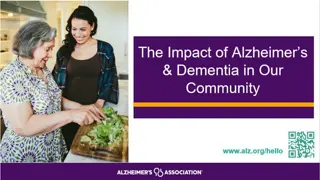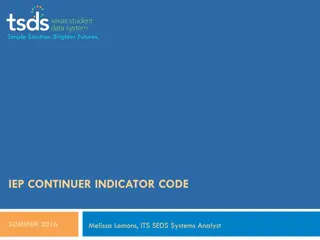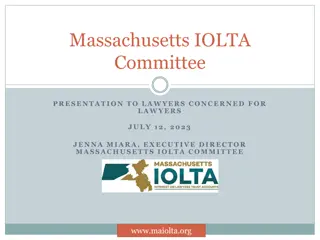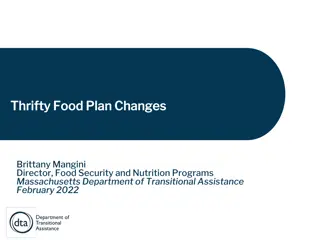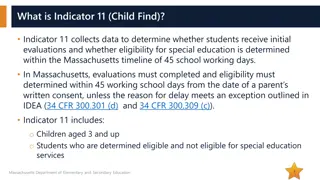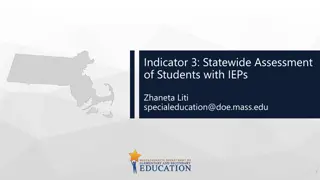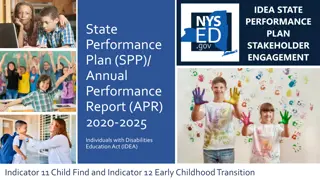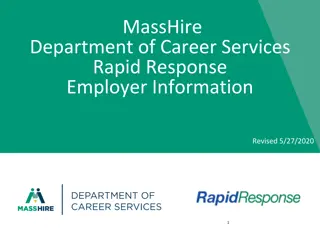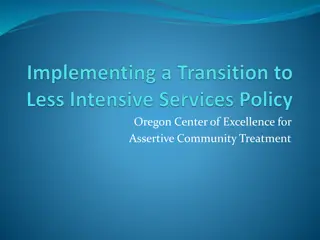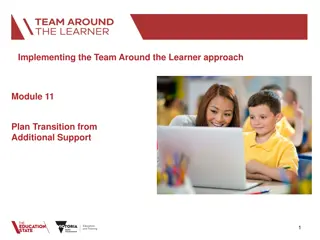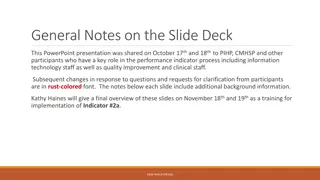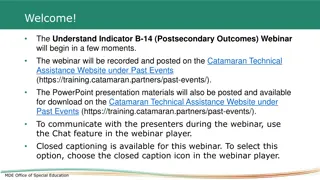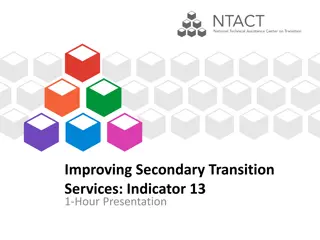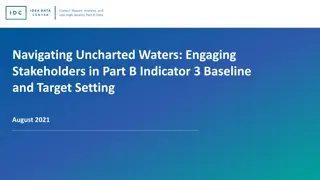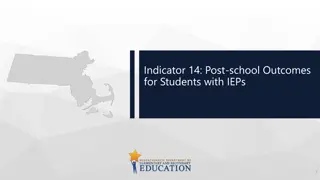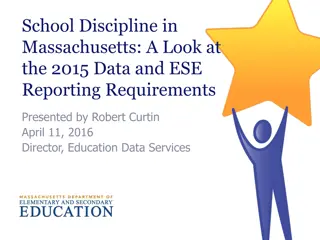Understanding Massachusetts Indicator 13 for Secondary Transition Planning
Indicator 13 in Massachusetts assesses the compliance of secondary transition planning and services for students with IEPs aged 14 and above, ensuring adherence to federal laws. The state collects data through file reviews to calculate a statewide compliance rate aiming for 100%. Compliance is measured by specific criteria related to postsecondary goals, transition services, and IEP team involvement. This indicator is crucial for promoting positive outcomes in education, employment, independent living, and community engagement for students with IEPs.
Download Presentation

Please find below an Image/Link to download the presentation.
The content on the website is provided AS IS for your information and personal use only. It may not be sold, licensed, or shared on other websites without obtaining consent from the author. Download presentation by click this link. If you encounter any issues during the download, it is possible that the publisher has removed the file from their server.
E N D
Presentation Transcript
What is Indicator 13 (Secondary Transition)? Indicator 13 checks to see whether Massachusetts students with Individualized Education Programs (IEPs) who are aged 14 and above receive secondary transition planning and services that comply with the federal Individuals with Disabilities Education Act (IDEA). IDEA transition planning and services are mandated in federal regulations in these and other sections: 300.43, 300.305, 300.320, 300.321, 300.322, 300.324, 300.520, 300.622. Massachusetts state law requires that transition planning and services begin no later than the student s 14thbirthday, two years earlier than the federal requirement of age 16. Therefore Massachusetts uses age 14 for the Indicator 13 review. 1 Massachusetts Department of Elementary and Secondary Education
How does Massachusetts collect Indicator 13 data? Each year, the Department of Elementary and Secondary Education (DESE) requires Massachusetts districts to review a sample of files for students with IEPs who are aged 14 and above, using a checklist with Indicator 13 requirements. The results of these file reviews are used in a federally required calculation to determine the statewide percentage rate for Indicator 13 compliance. Because this is a measure of compliance, the federal government requires a target of 100% compliance. 2 Massachusetts Department of Elementary and Secondary Education
How is the Indicator 13 statewide compliance rate measured? Percent of youth with IEPs aged 14 and above with an IEP that includes: o appropriate measurable postsecondary goals that are annually updated and based upon an age appropriate transition assessment, o transition services, including courses of study, that will reasonably enable the student to meet those postsecondary goals, o annual IEP goals related to the student s transition services needs. o evidence that the student was invited to the IEP Team meeting where transition services are to be discussed o evidence that, if appropriate, a representative of any participating agency that is likely to be responsible for providing or paying for transition services, including, if appropriate, pre-employment transition services, was invited to the IEP Team meeting with the prior consent of the parent or student who has reached the age of majority. 3 Massachusetts Department of Elementary and Secondary Education
Why is Indicator 13 important? Indicator 13 is one way that Massachusetts ensures that schools and districts comply with federal and state special education law. If students with IEPs have compliant secondary transition planning and services, they are more likely to have positive outcomes in post-high school education/training, employment, independent living, and community participation. Indicator 13 also helps DESE to understand which schools and districts may need additional professional development and other resources to support students secondary transition needs. 4 Massachusetts Department of Elementary and Secondary Education
Resources Secondary Transition: o DESE website: https://www.doe.mass.edu/sped/secondary-transition/default.html o Eleven Massachusetts parent/student brochures in 6 languages, https://fcsn.org/linkcenter/transition-resources/brochures/ o National Center for Parent Information and Resources: https://www.parentcenterhub.org/transitionadult/ Indicator 13: o Massachusetts Statewide and District-Specific Indicator Data, https://profiles.doe.mass.edu/statereport/special_education.aspx o Key to Terms and Phrases Used in the SPP/APR Indicator 13 Measurement, https://www.doe.mass.edu/sped/secondary-transition/indicator13-measurement.docx o Massachusetts Postsecondary Transition Planning: Goals Example Sheet, https://www.doe.mass.edu/sped/secondary-transition/indicator13-goals-example-sheet.docx o Transition Assessments Example Sheet, https://www.doe.mass.edu/sped/secondary- transition/indicator13-transition-assessment.docx 5 Massachusetts Department of Elementary and Secondary Education




